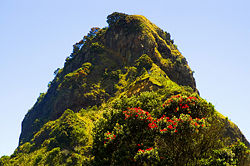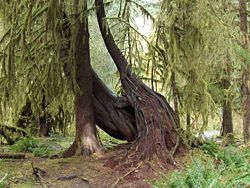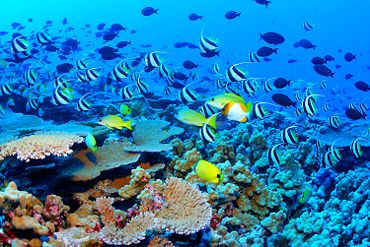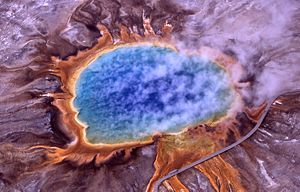Life
| Life (Biota) |
|---|
 Life on a rocky peak in the Waitakere Ranges
|
| Scientific classification |
|
|
| Domains and Kingdoms |
Life is a process that distinguishes organisms from non-living objects, such as non-life, and dead organisms. Living organisms are capable of growth and reproduction, some can communicate and many can adapt to their environment through changes originating internally.[1] A physical characteristic of life is that it feeds on negative entropy.[2][3] In more detail, according to physicists such as John Bernal, Erwin Schrödinger, Eugene Wigner, and John Avery, life is a member of the class of phenomena which are open or continuous systems able to decrease their internal entropy at the expense of substances or free energy taken in from the environment and subsequently rejected in a degraded form (see: entropy and life).[4][5]
An entity with the above properties is considered to be a living organism, hence, a 'life form'. However, not every definition of life considers all of these properties to be essential. For example, the capacity for evolution is sometimes taken as the only essential property of life; this definition notably includes viruses, which do not qualify under narrower definitions as they are acellular and do not metabolize.
A diverse array of living organisms can be found in the biosphere on Earth. Properties common to these organisms—plants, animals, fungi, protists, archaea and bacteria—are a carbon- and water-based cellular form with complex organization and heritable genetic information. They undergo metabolism, possess a capacity to grow, respond to stimuli, reproduce and, through natural selection, adapt to their environment in successive generations. So far, there is no evidence of extraterrestrial life.
Contents |
Definitions
There is no universal definition of life. To define life in unequivocal terms is still a challenge for scientists.[6][7]
Conventional definition: The consensus is that life is a characteristic of organisms that exhibit all or most of the following phenomena:[8][9]
- Homeostasis: Regulation of the internal environment to maintain a constant state; for example, electrolyte concentration or sweating to reduce temperature.
- Organization: Being composed of one or more cells, which are the basic units of life.
- Metabolism: Consumption of energy by converting chemicals and energy into cellular components (anabolism) and decomposing organic matter (catabolism). Living things require energy to maintain internal organization (homeostasis) and to produce the other phenomena associated with life.
- Growth: Maintenance of a higher rate of synthesis than catabolism. A growing organism increases in size in all of its parts, rather than simply accumulating matter. The particular species begins to multiply and expand as the evolution continues to flourish.
- Adaptation: The ability to change over a period of time in response to the environment. This ability is fundamental to the process of evolution and is determined by the organism's heredity as well as the composition of metabolized substances, and external factors present.
- Response to stimuli: A response can take many forms, from the contraction of a unicellular organism to external chemicals, to complex reactions involving all the senses of higher animals. A response is often expressed by motion, for example, the leaves of a plant turning toward the sun (phototropism) and chemotaxis.
- Reproduction: The ability to produce new organisms. Reproduction can be the division of one cell to form two new cells. Usually the term is applied to the production of a new individual (either asexually, from a single parent organism, or sexually, from at least two differing parent organisms), although strictly speaking it also describes the production of new cells in the process of growth.



Also, individual members of a species may not meet all the criteria, but are still considered alive, such as members of a species who are rendered unable to reproduce, or individuals in coma who are unable to respond to stimuli.
Viruses and aberrant prion proteins are most often considered replicators rather than forms of life, a distinction warranted because they cannot reproduce without very specialized substrates, such as host cells or proteins, respectively. Also, the Rickettsia and Chlamydia are examples of bacteria that cannot independently fulfill many vital biochemical processes, and depend on entry, growth, and replication within the cytoplasm of eukaryotic host cells. However, most forms of life rely on foods produced by other species, or at least the specific chemistry of Earth's environment.
The systemic definition of life is that living things are self-organizing and autopoietic (self-producing). Variations of this definition include Stuart Kauffman's definition of life as an autonomous agent or a multi-agent system capable of reproducing itself or themselves, and of completing at least one thermodynamic work cycle.
Proposed definitions of life, to reflect the minimum phenomena required:
- Living things are systems that tend to respond to changes in their environment, and inside themselves, in such a way as to promote their own continuation.[10]
- A network of inferior negative feedbacks (regulatory mechanisms) subordinated to a superior positive feedback (potential of expansion, reproduction).[11]
- A characteristic of self-organizing, self-recycling systems consisting of populations of replicators that are capable of mutation, around most of which homeostatic, metabolizing organisms evolve.
- Type of organization of matter producing various interacting forms of variable complexity, whose main property is to replicate almost perfectly by using matter and energy available in their environment to which they may adapt. In this definition "almost perfectly" relates to mutations happening during replication of organisms that may have adaptive benefits.
- Life is a potentially self-perpetuating open system of linked organic reactions, catalyzed simultaneously and almost isothermally by complex chemicals (enzymes) that are themselves produced by the open system.
Origin of life
- For religious beliefs about the creation of life, see creation myth.

Although it has not been pinpointed exactly, evidence suggests that life on Earth has existed for about 3.7 billion years.[12]
There is no truly "standard" model for the origin of life, but most currently accepted scientific models build in one way or another on the following discoveries, which are listed roughly in order of postulated emergence:
- Plausible pre-biotic conditions result in the creation of the basic small molecules of life. This was demonstrated in the Miller-Urey experiment, and in the work of Sidney Fox.
- Phospholipids spontaneously form lipid bilayers, the basic structure of a cell membrane.
- Procedures for producing random RNA molecules can produce ribozymes, which are able to produce more of themselves under very specific conditions.
- The panspermia hypothesis proposes that life originated elsewhere in the universe and was subsequently transferred to Earth perhaps via meteorites, comets or cosmic dust.
There are many different hypotheses regarding the path that might have been taken from simple organic molecules via pre-cellular life to protocells and metabolism. Many models fall into the "genes-first" category or the "metabolism-first" category, but a recent trend is the emergence of hybrid models that do not fit into either of these categories.[13]
Classification of life
Traditionally, people have divided organisms into the classes of plants and animals, based mainly on their ability of movement. The first known attempt to classify organisms was conducted by the Greek philosopher Aristotle. He classified all living organisms known at that time as either a plant or an animal. Aristotle distinguished animals with blood from animals without blood (or at least without red blood), which can be compared with the concepts of vertebrates and invertebrates respectively. He divided the blooded animals into five groups: viviparous quadrupeds (mammals), birds, oviparous quadrupeds (reptiles and amphibians), fishes and whales. The bloodless animals were also divided into five groups: cephalopods, crustaceans, insects (which also included the spiders, scorpions, and centipedes, in addition to what we now define as insects), shelled animals (such as most molluscs and echinoderms) and "zoophytes". Though Aristotle's work in zoology was not without errors, it was the grandest biological synthesis of the time, and remained the ultimate authority for many centuries after his death.[14]
The exploration of the American continent revealed large numbers of new plants and animals that needed descriptions and classification. In the latter part of the 16th century and the beginning of the 17th, careful study of animals commenced and was gradually extended until it formed a sufficient body of knowledge to serve as an anatomical basis for classification.
In the late 1740s, Carolus Linnaeus introduced his method, still used, to formulate the scientific name of every species.[15] Linnaeus took every effort to improve the composition and reduce the length of the many-worded names by abolishing unnecessary rhetoric, introducing new descriptive terms and defining their meaning with an unprecedented precision. By consistently using his system, Linnaeus separated nomenclature from taxonomy. This convention for naming species is referred to as binomial nomenclature.
The fungi were originally treated as plants. For a short period Linnaeus had placed them in the taxon Vermes in Animalia. He later placed them back in Plantae. Copeland classified the Fungi in his Protoctista, thus partially avoiding the problem but acknowledged their special status.[16] The problem was eventually solved by Whittaker, when he gave them their own kingdom in his five-kingdom system. As it turned out, the fungi are more closely related to animals than to plants.[17]
As new discoveries enabled us to study cells and microorganisms, new groups of life where revealed, and the fields of cell biology and microbiology were created. These new organisms were originally described separately in protozoa as animals and protophyta/thallophyta as plants, but were united by Haeckel in his kingdom protista, later the group of prokaryotes were split off in the kingdom Monera, eventually this kingdom would be divided in two separate groups, the Bacteria and the Archaea, leading to the six-kingdom system and eventually to the current three-domain system.[18] The classification of eukaryotes is still controversial, with protist taxonomy especially problematic.[19]
As microbiology, molecular biology and virology developed, non-cellular reproducing agents were discovered, such as viruses and viroids. Sometimes these entities are considered to be alive but others argue that viruses are not living organisms since they lack characteristics such as cell membrane, metabolism and do not grow or respond to their environments. Viruses can however be classed into "species" based on their biology and genetics, but many aspects of such a classification remain controversial.[20]
Since the 1960s a trend called cladistics has emerged, arranging taxa in an evolutionary or phylogenetic tree. It is unclear, should this be implemented, how the different codes will coexist.[21]
| Linnaeus 1735 2 kingdoms |
Haeckel 1866[22] 3 kingdoms |
Chatton 1937[23] 2 empires |
Copeland 1956[24] 4 kingdoms |
Whittaker 1969[25] 5 kingdoms |
Woese et al. 1977[26] 6 kingdoms |
Woese et al. 1990[18] 3 domains |
|---|---|---|---|---|---|---|
| (not treated) | Protista | Prokaryota | Monera | Monera | Eubacteria | Bacteria |
| Archaebacteria | Archaea | |||||
| Eukaryota | Protista | Protista | Protista | Eukarya | ||
| Vegetabilia | Plantae | Fungi | Fungi | |||
| Plantae | Plantae | Plantae | ||||
| Animalia | Animalia | Animalia | Animalia | Animalia |
Extraterrestrial life
Earth is the only planet in the universe known to harbour life. The Drake equation has been used to estimate the probability of life elsewhere, but scientists disagree on many of the values of variables in this equation (although strictly speaking Drake equation estimates relate the number of extraterrestrial civilizations in our galaxy with which we might come in contact - not probability of life elsewhere). Depending on those values, the equation may either suggest that life arises frequently or infrequently.
Panspermia and exogenesis are theories proposing that life originated elsewhere in the universe and was subsequently transferred to Earth in the form of spores perhaps via meteorites, comets or cosmic dust. However those theories do not help explain the ultimate origin of life.
See also
|
|
References
- ↑ "organism". Chambers 21st Century Dictionary (online). (1999).
- ↑ Schrödinger, Erwin (1944). What is Life?. Cambridge University Press. ISBN 0-521-42708-8.
- ↑ Margulis, Lynn; Sagan, Dorion (1995). What is Life?. University of California Press. ISBN 0-520-22021-8.
- ↑ Lovelock, James (2000). Gaia – a New Look at Life on Earth. Oxford University Press. ISBN 0-19-286218-9.
- ↑ Avery, John (2003). Information Theory and Evolution. World Scientific. ISBN 9812383999.
- ↑ Defining Life :: Astrobiology Magazine - earth science - evolution distribution Origin of life universe - life beyond
- ↑ Defining Life, Explaining Emergence
- ↑ Davison, Paul G.. "How to Define Life". The University of North Alabama. Retrieved on 2008-10-17.
- ↑ Witzany, G. (2007). The Logos of the Bios 2. Bio-Communication. Helsinki, Umweb.
- ↑ Witzany, G. (2007). The Logos of the Bios 2. Bio-Communication. Helsinki, Umweb.
- ↑ Korzeniewski, Bernard (2001). Cybernetic formulation of the definition of life. Journal of Theoretical Biology. 2001 Apr 7;209(3):275-86
- ↑ History of life through time
- ↑ Royal Society Publishing - Home
- ↑ "Aristotle -biography", University of California Museum of Paleontology. Retrieved on 2008-10-20.
- ↑ Knapp S, Lamas G, Lughadha EN, Novarino G (April 2004). "Stability or stasis in the names of organisms: the evolving codes of nomenclature". Philosophical transactions of the Royal Society of London. Series B, Biological sciences 359 (1444): 611–22. doi:. PMID 15253348. PMC: 1693349. http://journals.royalsociety.org/openurl.asp?genre=article&issn=0962-8436&volume=359&issue=1444&spage=611.
- ↑ Copeland, H. F. (1938). "The Kingdoms of Organisms". Quarterly Review of Biology 13 (4): 383. doi:. http://links.jstor.org/sici?sici=0033-5770(193812)13%3A4%3C383%3ATKOO%3E2.0.CO%3B2-K.
- ↑ Whittaker RH (January 1969). "New concepts of kingdoms or organisms. Evolutionary relations are better represented by new classifications than by the traditional two kingdoms". Science (journal) 163 (863): 150–60. PMID 5762760.
- ↑ 18.0 18.1 Woese C, Kandler O, Wheelis M (1990). "Towards a natural system of organisms: proposal for the domains Archaea, Bacteria, and Eucarya.". Proc Natl Acad Sci U S A 87 (12): 4576–9. doi:. PMID 2112744. http://www.pnas.org/cgi/reprint/87/12/4576.
- ↑ Adl SM, Simpson AG, Farmer MA, et al (2005). "The new higher level classification of eukaryotes with emphasis on the taxonomy of protists". J. Eukaryot. Microbiol. 52 (5): 399–451. doi:. PMID 16248873.
- ↑ Van Regenmortel MH (January 2007). "Virus species and virus identification: past and current controversies". Infection, genetics and evolution : journal of molecular epidemiology and evolutionary genetics in infectious diseases 7 (1): 133–44. doi:. PMID 16713373.
- ↑ Pennisi E (March 2001). "Taxonomy. Linnaeus's last stand?". Science (New York, N.Y.) 291 (5512): 2304–7. PMID 11269295. http://www.sciencemag.org/cgi/pmidlookup?view=long&pmid=11269295.
- ↑ E. Haeckel (1866). Generelle Morphologie der Organismen. Reimer, Berlin.
- ↑ E. Chatton (1937). Titres et travaux scientifiques. Sette, Sottano, Italy.
- ↑ H. F. Copeland (1956). The Classification of Lower Organisms. Palo Alto: Pacific Books.
- ↑ R. H. Whittaker (1969). "New concepts of kingdoms of organisms". Science 163: 150–160.
- ↑ C. R. Woese, W. E. Balch, L. J. Magrum, G. E. Fox and R. S. Wolfe (1977). "An ancient divergence among the bacteria". Journal of Molecular Evolution 9: 305–311.
Further reading
- Kauffman, Stuart. The Adjacent Possible: A Talk with Stuart Kauffman. Retrieved Nov. 30, 2003 from [1]
- Walker, Martin G. LIFE! Why We Exist...And What We Must Do to Survive (Book Page) (Web Site), Dog Ear Publishing, 2006, ISBN 1-59858-243-7
External links
- Wikispecies - a free directory of life
- "The Adjacent Possible: A Talk with Stuart Kauffman"
- Stanford Encyclopedia of Philosophy entry
- Life under extreme conditions An in depth look at how life can form under the most extreme conditions.
| Taxonomic ranks | ||||||||
|---|---|---|---|---|---|---|---|---|
| Magnorder | ||||||||
| Domain/Superkingdom | Superphylum/Superdivision | Superclass | Superorder | Superfamily | Superspecies | |||
| Kingdom | Phylum/Division | Class | Legion | Order | Family | Tribe | Genus | Species |
| Subkingdom | Subphylum | Subclass | Cohort | Suborder | Subfamily | Subtribe | Subgenus | Subspecies |
| Infrakingdom/Branch | Infraphylum | Infraclass | Infraorder | Alliance | Infraspecies | |||
| Microphylum | Parvclass | Parvorder | ||||||
|
||||||||||||||||||||
|
|||||||||||||||||||||||||||||
